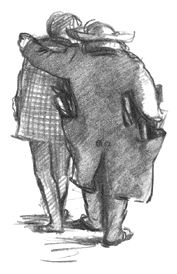Vie de Boheme – how the Bohemian Club was formed

13 of 24
Under each name were written the biggest sum that could be borrowed, in view of that person’s state of fortune; the times at which he was in funds; and the hours of meals, with notes on the sort of meal usually provided. Besides this table, Schaunard had a little file of accounts, kept in perfect order, in which he noted , to the smallest detail, the sums lent him. He did not wish to encumber himself beyond a certain figure, which was still at the end of the pen of a Norman uncle to whom he was heir. As soon as he owed an individual twenty francs, Schaunard closed his account and settled it in a lump, even if this meant borrowing from people to whom he owed less. In this fashion, he always maintained a certain credit, which he called his ‘floating debt’. And since it was known that he always paid back as soon as his personal resources allowed, people were willing to oblige him when they could.
On this occasion, then, ever since leaving his room at eleven in the morning, Schaunard had been trying to assemble the necessary seventy-five francs. But he had collected altogether only one solitary crown – the result of the united efforts of the letters M, V and R on his famous list. The rest of the alphabet, owing rent like himself, had been entirely unable to oblige.
At six o’clock a violent appetite rang the dinner-bell in his stomach. He happened to be at the Barrière du Maine, where the letter U lived; so he went up to visit the letter U, where he kept a napkin ring, whenever there were any napkins.
“Where do you wish to go, sir?” asked the janitor, stopping him in the passage.
“To Monsieur U.”
“He’s not in.”
“Is madame U in?”
“She’s not in, either. They told me to tell a friend of theirs, who’d be visiting them this evening, that they were dining out. In fact, if it’s you they were expecting, here’s the address they left.” The janitor showed Schaunard a scrap of paper, on which his friend U had written:
Gone to dine with Schaunard, Rue –, No –. Come and join us.
“The farcical tricks of coincidence!” Schaunard reflected, as he went away. He remembered that he was within a few yards of a little pot-house where he had once or twice eaten at no great cost, and directed his steps to this establishment, which is on the Chaussée du Maine and whose name, Mother Cadet’s, is well known in Low Bohemia. It is an eating-and-drinking house, whose regular customers are carters from the Route d’Orleans, women singers from Montparnasse and male stars from the Bobino music hall. In the warmer months, art students from the numerous studios round the Luxembourg, unpublished men-of-letters and hacks employed by mysterious periodicals come in droves to Mother Cadet’s, which is famous for its rabbit-stew, its genuine choucroute and a watery white wine with a flavour of musket-flints.
[To be continued …]
[Vie de Bohème by Henry Mürger, a vivid portrait of the ‘Bohemian’ life of the artistic quarter of Paris in the nineteenth century was originally published (by Michel Lévy) in 1851. The extract above is taken from a translation by Norman Cameron, published by Hamish Hamilton. The illustration is by Dodi Masterman.]
Leave a Response
You must be logged in to post a comment.

